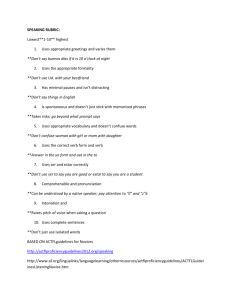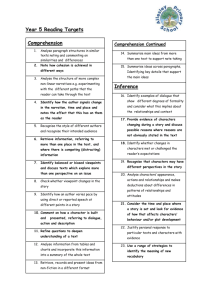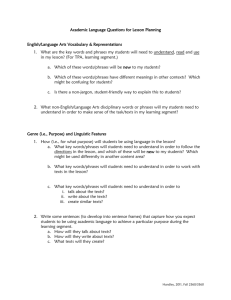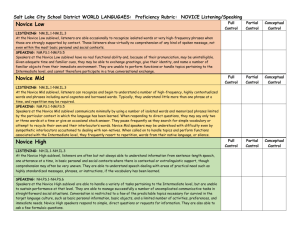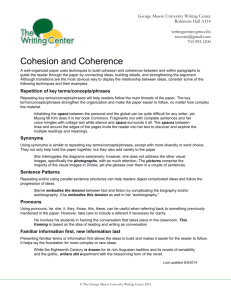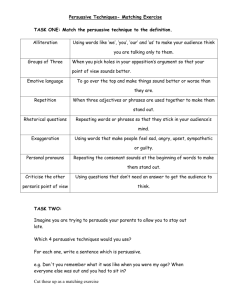Anexo I
advertisement
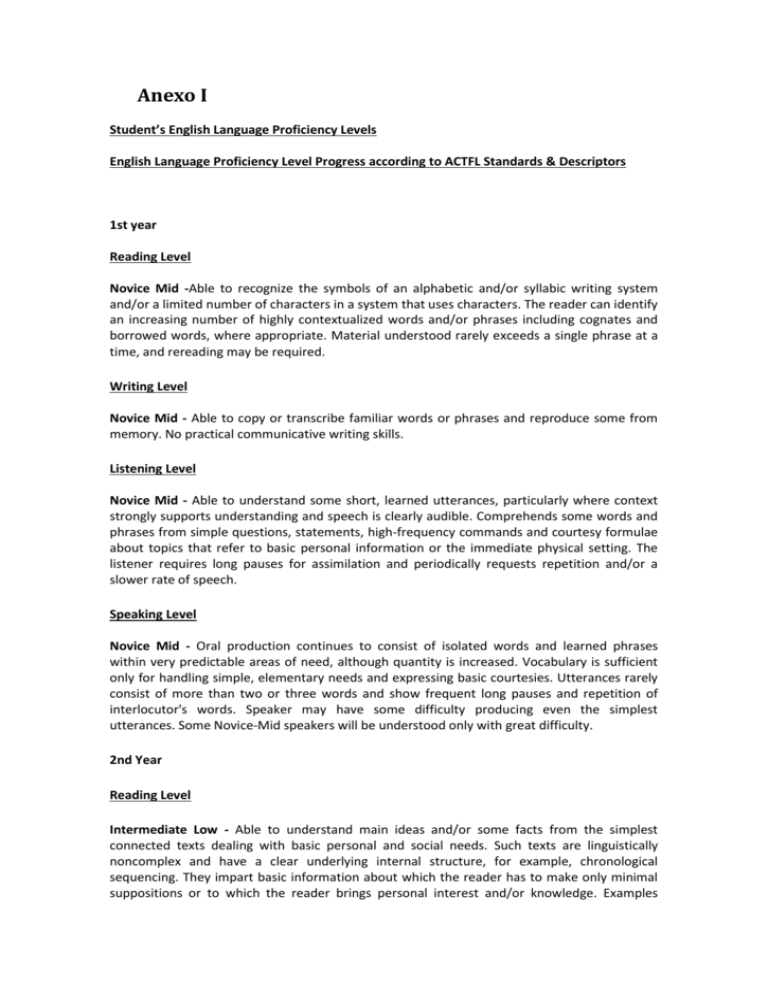
Anexo I Student’s English Language Proficiency Levels English Language Proficiency Level Progress according to ACTFL Standards & Descriptors 1st year Reading Level Novice Mid -Able to recognize the symbols of an alphabetic and/or syllabic writing system and/or a limited number of characters in a system that uses characters. The reader can identify an increasing number of highly contextualized words and/or phrases including cognates and borrowed words, where appropriate. Material understood rarely exceeds a single phrase at a time, and rereading may be required. Writing Level Novice Mid - Able to copy or transcribe familiar words or phrases and reproduce some from memory. No practical communicative writing skills. Listening Level Novice Mid - Able to understand some short, learned utterances, particularly where context strongly supports understanding and speech is clearly audible. Comprehends some words and phrases from simple questions, statements, high-frequency commands and courtesy formulae about topics that refer to basic personal information or the immediate physical setting. The listener requires long pauses for assimilation and periodically requests repetition and/or a slower rate of speech. Speaking Level Novice Mid - Oral production continues to consist of isolated words and learned phrases within very predictable areas of need, although quantity is increased. Vocabulary is sufficient only for handling simple, elementary needs and expressing basic courtesies. Utterances rarely consist of more than two or three words and show frequent long pauses and repetition of interlocutor's words. Speaker may have some difficulty producing even the simplest utterances. Some Novice-Mid speakers will be understood only with great difficulty. 2nd Year Reading Level Intermediate Low - Able to understand main ideas and/or some facts from the simplest connected texts dealing with basic personal and social needs. Such texts are linguistically noncomplex and have a clear underlying internal structure, for example, chronological sequencing. They impart basic information about which the reader has to make only minimal suppositions or to which the reader brings personal interest and/or knowledge. Examples include messages with social purposes and information for the widest possible audience, such as public announcements and short, straightforward instructions dealing with public life. Some misunderstandings will occur. Writing Level Intermediate Low - Able to meet limited practical writing needs. Can write short messages, postcards, and take down simple notes, such as telephone messages. Can create statements or questions within the scope of limited language experience. Material produced consists of recombinations of learned vocabulary and structures into simple sentences on very familiar topics. Listening Level Novice High - Able to understand short, learned utterances and some sentence-length utterances, particularly where context strongly supports understanding and speech is clearly audible. Comprehends words and phrases from simple questions, statements, high-frequency commands, and courtesy formulae. May require repetition, rephrasing, and/or a slowed rate of speech for comprehension. Speaking Level Novice High - Able to satisfy partially the requirements of basic communicative exchanges by relying heavily on learned utterances but occasionally expanding these through simple recombinations of their elements. Can ask questions or make statements involving learned material. Shows signs of spontaneity although this falls short of real autonomy of expression. Speech continues to consist of learned utterances rather than of personalized, situationally adapted ones. Vocabulary centers on areas such as basic objects, places, and most common kinship terms. Pronunciation may still be strongly influenced by first language. Errors are frequent and, in spite of repetition, some Novice-High speakers will have difficulty being understood even by sympathetic interlocutors. 3rd Year Reading Level Intermediate Mid - Able to read consistently with increased understanding simple, connected texts dealing with a variety of basic and social needs. Such texts are still linguistically noncomplex and have a clear underlying internal structure. They impart basic information about which the reader has to make minimal suppositions and to which the reader brings personal interest and/or knowledge. Examples may include short, straightforward descriptions of persons, places, and things written for a wide audience. Writing Level Intermediate Mid - Able to meet a number of practical writing needs. Can write short, simple letters. Content involves personal preferences, daily routine, everyday events, and other topics grounded in personal experience. Can express present time and at least one other time frame or aspect consistently, e.g., nonpast, habitual, imperfective. Evidence of control of the syntax of non-complex sentences and basic inflectional morphology, such as declensions and conjugation. Writing tends to be a loose collection of sentences or sentence fragments on a given topic and provides little evidence of conscious organization. Can be understood by natives used to the writing of non-natives. Listening Level Intermediate Low - Able to understand sentence-length utterances which consist of recombinations of learned elements in a limited number of content areas, particularly if strongly supported by the situational context. Content refers to basic personal background and needs, social conventions and routine tasks, such as getting meals and receiving simple instructions and directions. Listening tasks pertain primarily to spontaneous face-to-face conversations. Understanding is often uneven; repetition and rewording may be necessary. Misunderstandings in both main ideas and details arise frequently. Speaking Level Intermediate Low - Able to handle successfully a limited number of interactive, task-oriented, and social situations. Can ask and answer questions, initiate and respond to simple statements, and maintain face-to-face conversation, although in a highly restricted manner and with much linguistic inaccuracy. Within these limitations, can perform such tasks as introducing self, ordering a meal, asking directions, and making purchases. Vocabulary is adequate to express only the most elementary needs. Strong interference from native language may occur. Misunderstandings frequently arise, but with repetition, the Intermediate-Low speaker can generally be understood by sympathetic interlocutors. Anexo II Teachers’ English Language Proficiency Levels according to ACTFL Standards & Descriptors English Language Arts Teacher ( Lead teacher responsible for English language 90-10 instruction and development of reading / writing / listening / speaking according to the ACTFUL Standards and Language Proficiency descriptors) Intermediate High to Low Advanced in Reading / Writing / Listening / Speaking according to ACTFL standards and descriptors is highly recommended. Reading Level Intermediate High - Able to read consistently with full understanding simple connected texts dealing with basic personal and social needs about which the reader has personal interest and/or knowledge. Can get some main ideas and information from texts at the next higher level featuring description and narration. Structural complexity may interfere with comprehension; for example, basic grammatical relations may be misinterpreted and temporal references may rely primarily on lexical items. Has some difficulty with the cohesive factors in discourse, such as matching pronouns with referents. While texts do not differ significantly from those at the Advanced level, comprehension is less consistent. May have to read material several times for understanding. Advanced - Able to read somewhat longer prose of several paragraphs in length, particularly if presented with a clear underlying structure. The prose is predominantly in familiar sentence patterns. Reader gets the main ideas and facts and misses some details. Comprehension derives not only from situational and subject matter knowledge but from increasing control of the language. Texts at this level include descriptions and narrations such as simple short stories, news items, bibliographical information, social notices, personal correspondence, routinized business letters, and simple technical material written for the general reader. Writing Level Intermediate High - Able to meet most practical writing needs and limited social demands. Can take notes in some detail on familiar topics and respond in writing to personal questions. Can write simple letters, brief synopses and paraphrases, summaries of biographical data, work and school experience. In those languages relying primarily on content words and time expressions to express time, tense, or aspect, some precision is displayed; where tense and/or aspect is expressed through verbal inflection, forms are produced rather consistently, but not always accurately. An ability to describe and narrate in paragraphs is emerging. Rarely uses basic cohesive elements such as pronominal substitutions or synonyms in written discourse. Writing, though faulty, is generally comprehensible to natives used to the writing of nonnatives. Advanced - Able to write routine social correspondence and join sentences in simple discourse of at least several paragraphs in length on familiar topics. Can write simple social correspondence, take notes, write cohesive summaries and resumes, as well as narratives and descriptions of a factual nature. Has sufficient writing vocabulary to express self simply with some circumlocution. May still make errors in punctuation, spelling, or the formation of nonalphabetic symbols. Good control of the morphology and the most frequently used syntactic structures, e.g., common word order patterns, coordination, subordination, but makes frequent errors in producing complex sentences. Uses a limited number of cohesive devices, such as pronouns, accurately. Writing may resemble literal translations from the native language, but a sense of organization (rhetorical structure) is emerging. Writing is understandable to natives not used to the writing of non-natives. Listening Level Intermediate High - Able to sustain understanding over longer stretches of connected discourse on a number of topics pertaining to different times and places; however, understanding is inconsistent due to failure to grasp main ideas and/or details. Thus, while topics do not differ significantly from those of an Advanced level listener, comprehension is less in quantity and poorer in quality. Advanced - Able to understand main ideas and most details of connected discourse on a variety of topics beyond the immediacy of the situation. Comprehension may be uneven due to a variety of linguistic and extralinguistic factors, among which topic familiarity is very prominent. These texts frequently involve description and narration in different time frames or aspects, such as present, nonpast, habitual, or imperfective. Texts may include interviews, short lectures on familiar topics, and news items and reports primarily dealing with factual information. Listener is aware of cohesive devices but may not be able to use them to follow the sequence of thought in an oral text. Speaking Level Intermediate High - Able to handle successfully most uncomplicated communicative tasks and social situations. Can initiate, sustain, and close a general conversation with a number of strategies appropriate to a range of circumstances and topics, but errors are evident. Limited vocabulary still necessitates hesitation and may bring about slightly unexpected circumlocution. There is emerging evidence of connected discourse, particularly for simple narration and/or description. The Intermediate-High speaker can generally be understood even by interlocutors not accustomed to dealing with speakers at this level, but repetition may still be required. Advanced - Able to satisfy the requirements of everyday situations and routine school and work requirements. Can handle with confidence but not with facility complicated tasks and social situations, such as elaborating, complaining, and apologizing. Can narrate and describe with some details, linking sentences together smoothly. Can communicate facts and talk casually about topics of current public and personal interest, using general vocabulary. Shortcomings can often be smoothed over by communicative strategies, such as pause fillers, stalling devices, and different rates of speech. Circumlocution which arises from vocabulary or syntactic limitations very often is quite successful, though some groping for words may still be evident. The Advanced-level speaker can be understood without difficulty by native interlocutors. Geography and Math Teachers English Language Proficiency Level According to ACTFL Standards & Descriptors (In order for Geography and Math teachers to be able to implement the curriculum effectively, it is highly recommended that these teachers have a minimum of Novice Mid as their English proficiency level.) Reading Level Novice Mid - Able to recognize the symbols of an alphabetic and/or syllabic writing system and/or a limited number of characters in a system that uses characters. The reader can identify an increasing number of highly contextualized words and/or phrases including cognates and borrowed words, where appropriate. Material understood rarely exceeds a single phrase at a time, and rereading may be required. Writing Level Novice Mid - Able to copy or transcribe familiar words or phrases and reproduce some from memory. No practical communicative writing skills. Listening Level Novice Mid - Able to understand some short, learned utterances, particularly where context strongly supports understanding and speech is clearly audible. Comprehends some words and phrases from simple questions, statements, high-frequency commands and courtesy formulae about topics that refer to basic personal information or the immediate physical setting. The listener requires long pauses for assimilation and periodically requests repetition and/or a slower rate of speech. Speaking Level Novice Mid - Oral production continues to consist of isolated words and learned phrases within very predictable areas of need, although quantity is increased. Vocabulary is sufficient only for handling simple, elementary needs and expressing basic courtesies. Utterances rarely consist of more than two or three words and show frequent long pauses and repetition of interlocutor's words. Speaker may have some difficulty producing even the simplest utterances. Some Novice-Mid speakers will be understood only with great difficulty.

